OBJECT LESSON
Cripping St. Roch
Considering Disability Aesthetics in Premodern Visual Culture
Bianca Frohne
Image
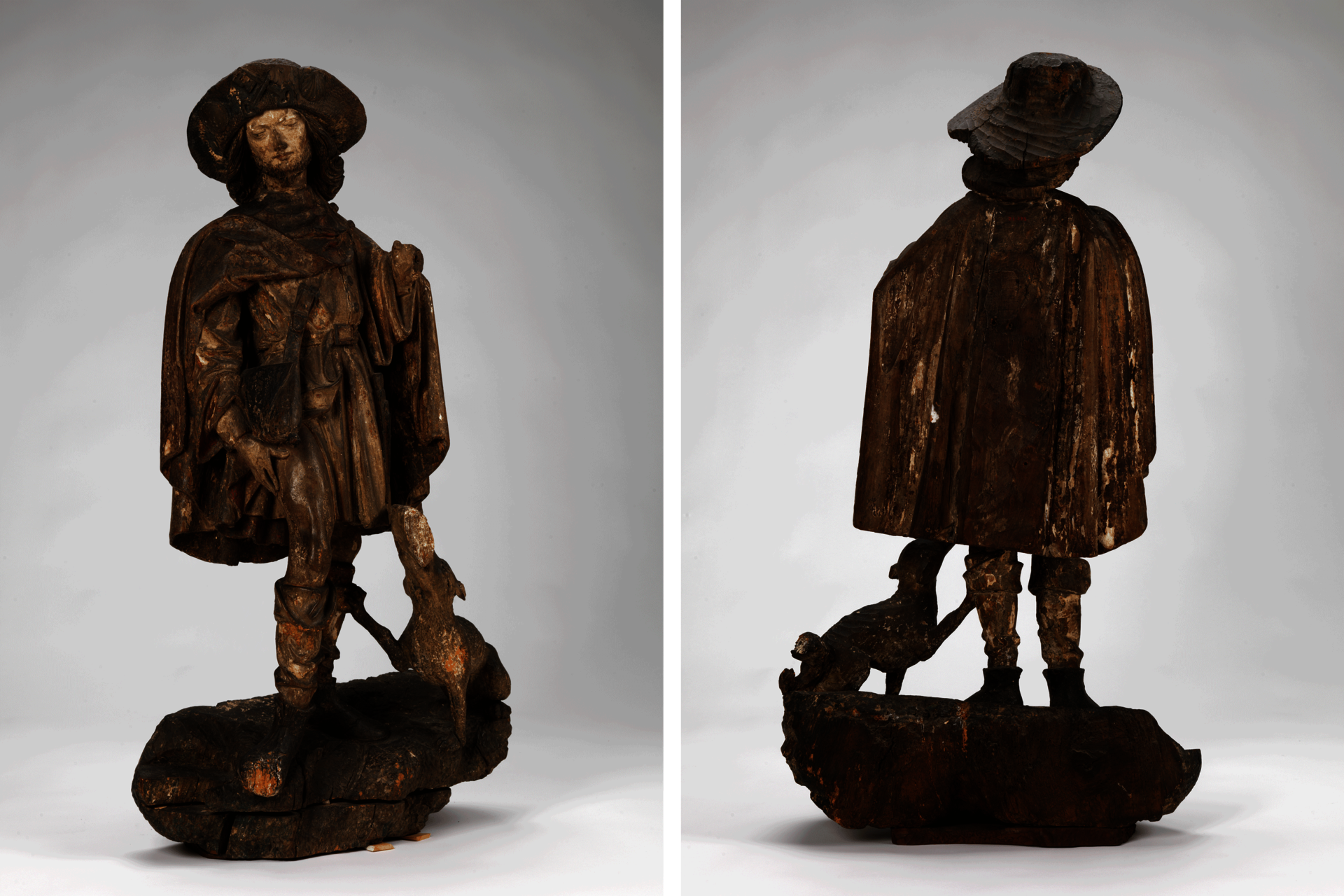
1
FIG. 1
French
Saint Roch, ca. 1500
Wood with polychromy
Height: 105.4 cm. (41 1/2 in.)
Museum Appropriation Fund 21.398
The European galleries at the RISD Museum hold a wooden sculpture of Saint Roch [Fig. 1].1 To a modern audience, it appears strangely moving. The statue was made around 1500, in the transition period from late medieval to early modern times. It was once covered in multicolored paint, but today the colors are faded and the paint has become brittle, emphasizing the sense of vulnerability the statue exudes. We do not know much about this work: it is likely that the sculpture was displayed in a church. It appears to be French in origin, but it is not known who made it or by whom it was commissioned.2 How might the sculpture have been regarded by its contemporaries, and what reactions, or forms of interaction, did it evoke?
St. Roch was one of the most venerated saints of the later Middle Ages. His cult spread very rapidly across Europe over the course of the fifteenth century and is closely linked with the plague, which had become endemic in Europe during that time. In comparison with older saints promising protection against infectious disease, most notably St. Sebastian [Fig. 2], St. Roch was an outright newcomer. Despite—or even because of—his cult’s novelty, it had a massive impact. There is a wealth of visual representation in the form of sculptures and paintings still extant today, and numerous chapels and churches throughout Europe are dedicated to St. Roch.3
Image
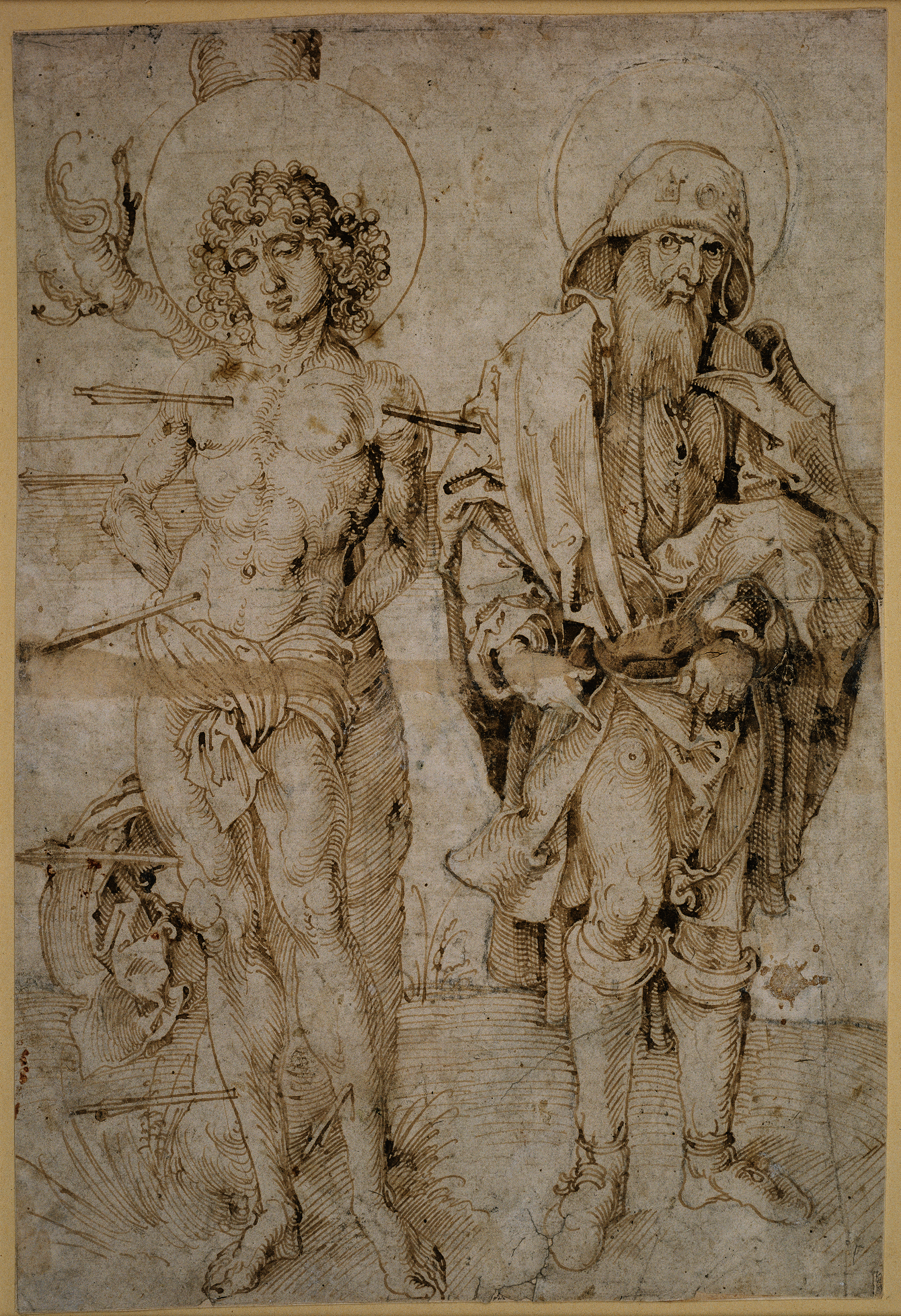
Albrecht Dürer
German, 1471–1528
Saints Sebastian and Roch, ca. 1496
Pen and ink over silverpoint on handmade paper
29.8 × 20.2 cm. (11 ¾ × 7 15/16 in.)
bpk-Bildagentur / Städel Museum /
Frankfurt am Main / Germany /
Photo: Ursula Edelmann / Art Resource, NY
One of the main reasons for this remarkable devotion, and the basis of his status as a patron saint against the plague, is St. Roch’s personal history as someone who lived with illness and pain. According to descriptions of his life (vitae), he contracted bubonic plague and survived a prolonged phase of severe illness.4 Even after he was healed thanks to miraculous intervention, his body was marked by the illness. It is thought that his popularity as a patron for the sick stems from the convergence of his experiences with those of his contemporaries: he had lived through the same pain and fear that they did, and he had managed to overcome both by trusting in God.5
Accounts about his life vary, and it is quite possible that the person his legend is based on never even existed.6 The most important aspects of his story, however, have been passed on since the last quarter of the fifteenth century, and can be summed up as follows: Roch was a nobleman from Montpellier, a city on the southern coast of France.7 After the death of his parents, he gave the family’s worldly possessions away and went on a pilgrimage to Rome. During his travels in Italy, he miraculously healed many people who had contracted the plague. When he fell ill with the disease himself, he retreated into the woods near Piacenza, where a dog owned by a rich man living nearby brought Roch daily provisions of bread. He was also led miraculously to a spring of water that helped him to endure fever and pain. Finally, he was healed, assisted, in some versions of the legend, by an angel. When he had recovered, he was set to return to Montpellier. On his way home, disfigured by illness and hardship, he was not recognized, and was taken for a spy. He was imprisoned and finally died after five years of captivity. After his death, a birthmark on his body revealed that he was related to the ruler who had ordered him to be jailed.
The veneration of a saintly figure based on his experience of illness, pain, and altered bodily state is a phenomenon that we might approach within the contemporary context of disability experience. While neither the word disability nor our modern concept of it existed in premodern times, the perspectives of disability historians and crip theorists are essential when dealing with images of illness, impairment, and pain in medieval and early modern culture. Over the last decades, disability reserachers have shown that “abilities” and “disabilities” are not fixed ahistorical categories, but products of social and cultural processes. In this regard, the study of images is of crucial importance.8 However, until recently, the visual culture of disability in premodern societies has been studied from a medical perspective, with an interest in retrospective diagnosis, clinical labels, and the (in)accuracies of depicted conditions and symptoms.9 For a long time, resesearchers in art history have focused on “cases” with visible illnesses or impairments, thereby restricting attention to a limited set of visualizations and iconographical tropes, such as the figure of the (male) beggar with mobility aids [Fig. 3].10 These images were thought to reflect a general understanding of medieval and early modern disability, based on the notion that the experiences of disabled people were shaped mainly by poverty and destitution.
Image
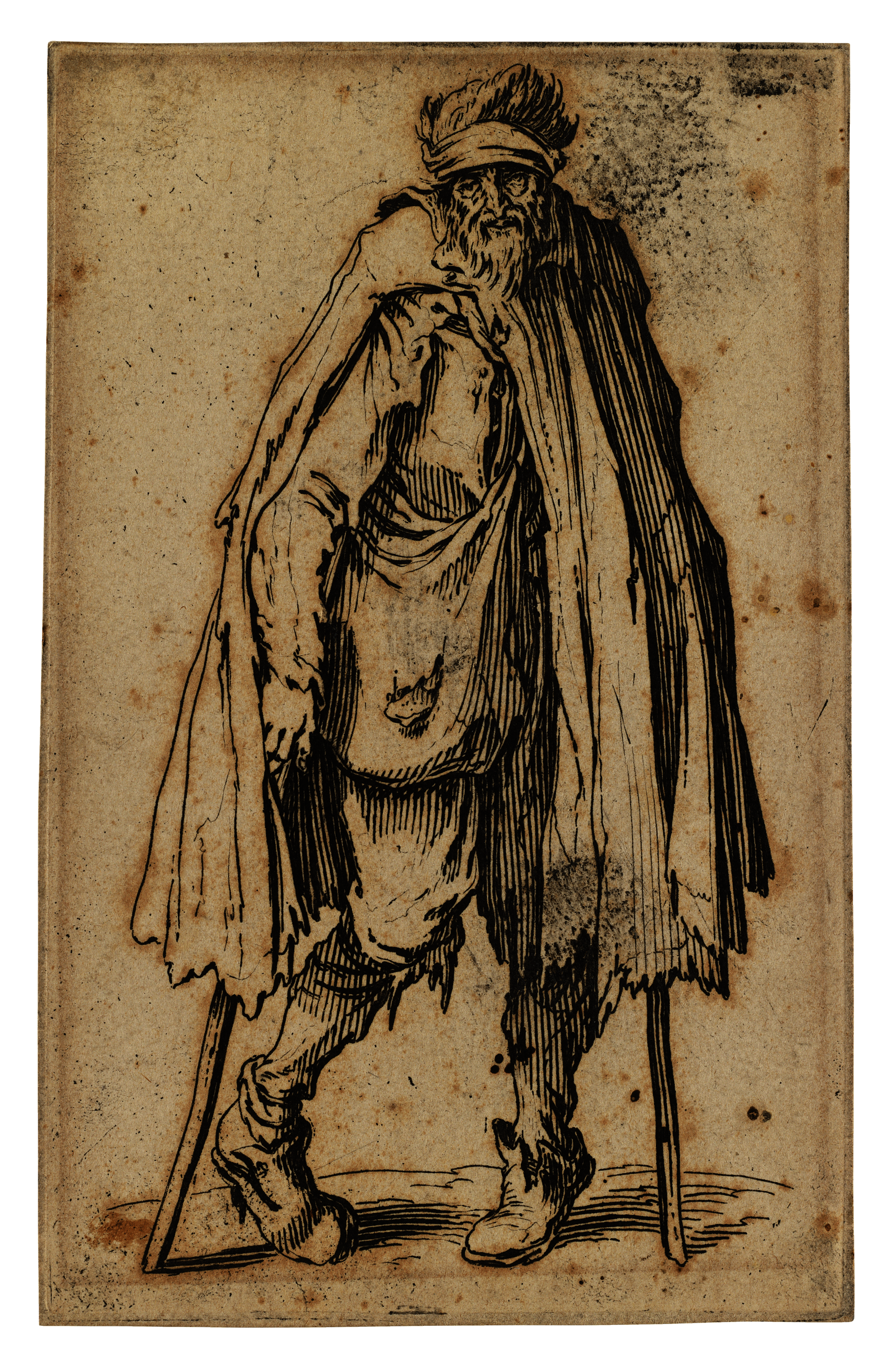
3
FIG. 3
Jacques Callot
French, 1592–1635
Beggar with Crutches and Wallet,
from the series The Beggars,
ca. 1622-1623
Etching on paper
Image/sheet: 13.8 × 8.7 cm. (5 7/16 × 3 7/16 in.)
Gift of the Fazzano Brothers 84.198.1236
However, this one-sided picture has failed to account for the complex and diverse experiences of disabled people in the past, and the varied, sometimes even contradictory concepts of embodiment prevalent in premodern societies. In this regard, the study of visual (and non-visual) practices relating to different corporeal states and bodily experiences must become a central field of interest within disability history. Even more, they would allow us to approach visual culture in general from a critical crip perspective that also challenges our own ways of looking at (premodern) art works and pictorial representations.
Such a change in perspective means to take into account a more diverse range of image production, different modes of perception, and unfamiliar aesthetic practices. To achieve this, the application of disability theorist Tobin Siebers’s concept of disability aesthetics holds a lot of promise. Siebers understands disability aesthetics as a way to study imagery that references or evokes “the body and its affective sphere,” including “the sensations that some bodies feel in the presence of other bodies.”11 This pertains, for example, to works that address wounds, injuries, pain, trauma, death, and mortality.12 This field of research is of special interest to premodern disability history as well, because it allows for a study of aesthetic practices centered on the materiality, vulnerability, and permeability of the human body.
Image

4
FIG. 4
French
Saint Roch, ca. 1500
Wood with polychromy (colored paint)
105.4 cm. (41 1/2 in.)
Museum Appropriation Fund 21.398
On several levels, the wooden statue of St. Roch in the RISD Museum [Fig. 4] exemplifies what can be gained from such an approach. The saint is depicted as a lightly bearded youngish man with neatly styled shoulder-length locks. His elegant clothes befit the status of “a gentleman of the period.”13 Immediately noticeable, however, are his wide-brimmed hat—adorned with the familiar insignia of a pilgrim, scallop shells, and crossed keys—and the characteristic pilgrim robe, beneath which he wears a bag across his upper body. The robe is folded back across his right shoulder and pulled aside, highlighting the gesture that is central to the figure’s composition: in an unobtrusive but quietly emphatic way, the saint presents the swelling caused by the plague in his right thigh. His right hand, two fingers pointing downward, rests lightly on his leg, while the act of subtly pulling back the robe creates a visual dynamic that focuses the attention on the upper leg. At the saint’s feet sits a dog gingerly holding a loaf of bread between its teeth; its head is raised up in an effort to offer this nourishment. One of the dog’s paws rests on Roch’s left boot, in a gesture that appears comforting and trusting at the same time. The dog’s tense posture, caused by his visible effort to alleviate the saint’s suffering, mirrors the dynamic composition surrounding the presentation of the thigh wound: the dog’s raised front leg corresponds to the saint’s pointing gesture, while his right arm, accentuated by the folded robe and the pilgrim bag across his body, directs the viewer’s gaze in a downward arch. Thus, the saint’s posture as well as the dog’s insistent gesture come together to frame, center, and highlight the visible mark of illness on the upper thigh. Roch’s facial expression also underlines the significance of his wound. His head is tilted to the right side and his gaze is turned slightly downwards in an expression of patient suffering that further directs the viewer’s attention to the right side of his body. From the remaining paint, it appears that his face might have been covered in sores and blisters as well.
Image
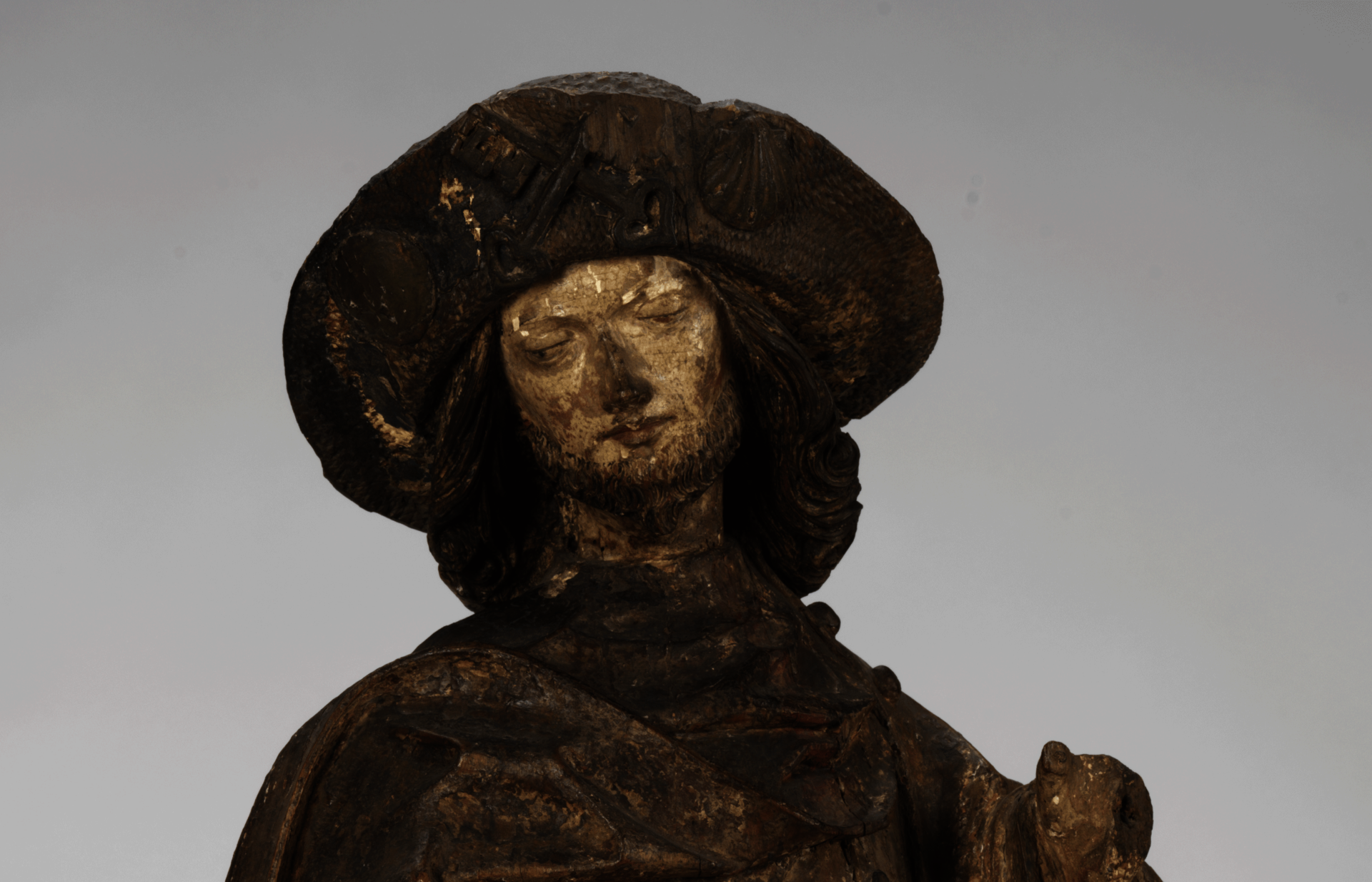
Image
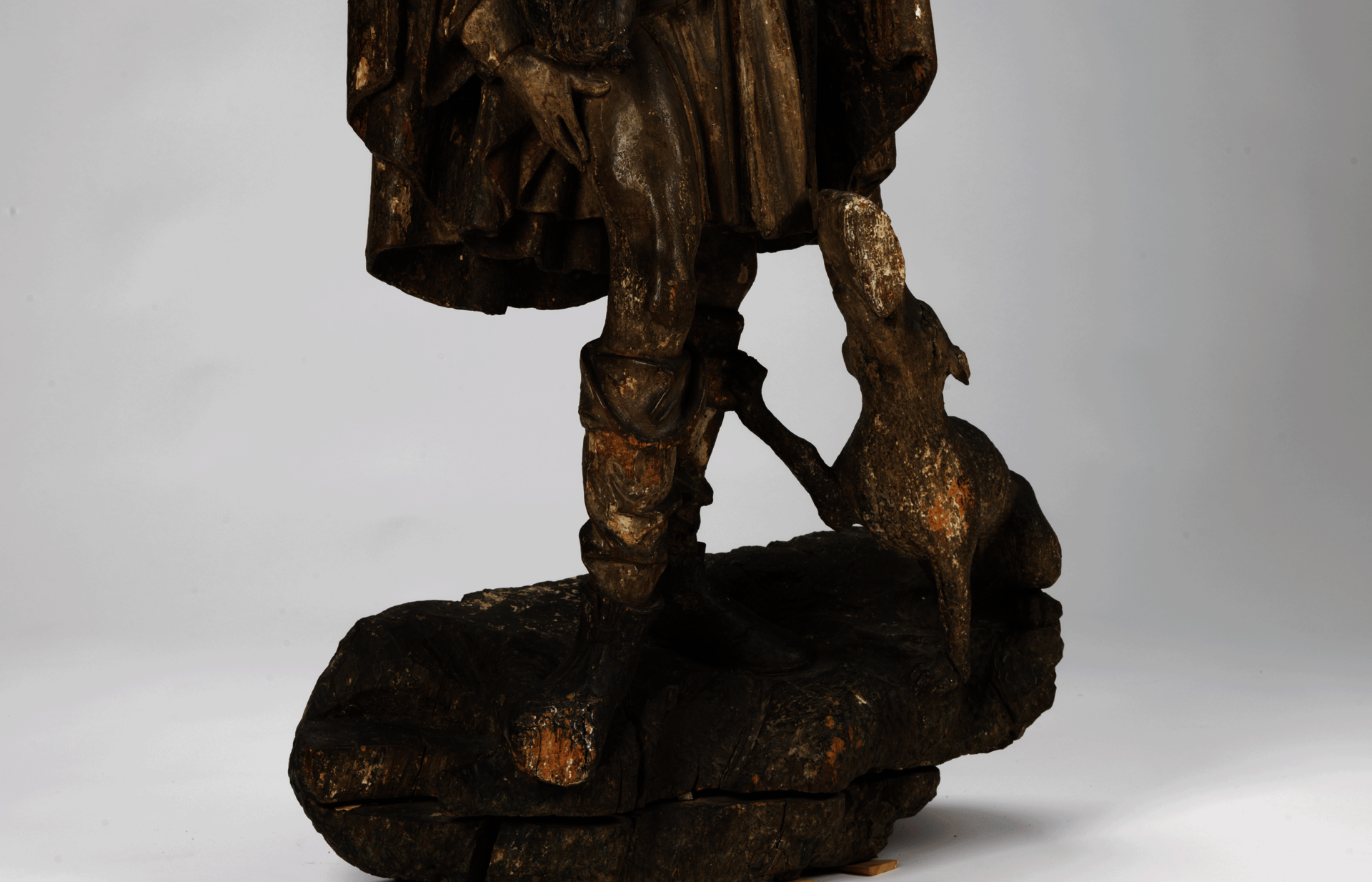
Overall, his facial expression is one of quiet acceptance and contemplation while nevertheless conveying illness and exhaustion. This impression is also borne out by the overall composition, which is harmoniously balanced but also charged with an underlying sense of tension, as if to reference the strain on the saint’s body. It is an image of profound vulnerability, expressed in a graceful, even playful composition: here, vulnerability is the cause of confidence and strength, without taking away from the underlying illness and pain. It could be argued that this form of visual representation points to aesthetic practices based on a shared knowledge of pain and illness. Indeed, many of the surviving images and sculptures of St. Roch convey a similar sense of vulnerability [Fig. 5].
Underlying this imagery might be an understanding of the human body that is quite different from our own today: late medieval and early modern bodies were thought to be permeable, shaped continuously by inner and outer dynamics, which is why they were prone to unforeseen, violent transformation at any time. Consequently, the human body, comprising an array of humors and other changeable substances, was essentially always in flux, its stability and materiality only ever preliminary. It is interesting that many of the visual representations of patrons against the plague, such as St. Roch and St. Sebastian, are depicted in a state that refers to this permeability and vulnerability: while Roch’s body is visibly marked by the inner workings of illness, Sebastian’s is pierced by arrows. Countless votive images and broadsheets against pestilence show Roch and Sebastian in such a way—these pictorial representations were apparently thought to have an apotropaic effect [Fig. 6]. Both saints were known for having survived life-threatening, highly painful illness or injuries. Their experiences and the resulting imagery gained them a reputation of offering powers of protection against illness and epidemic disease.14
Image
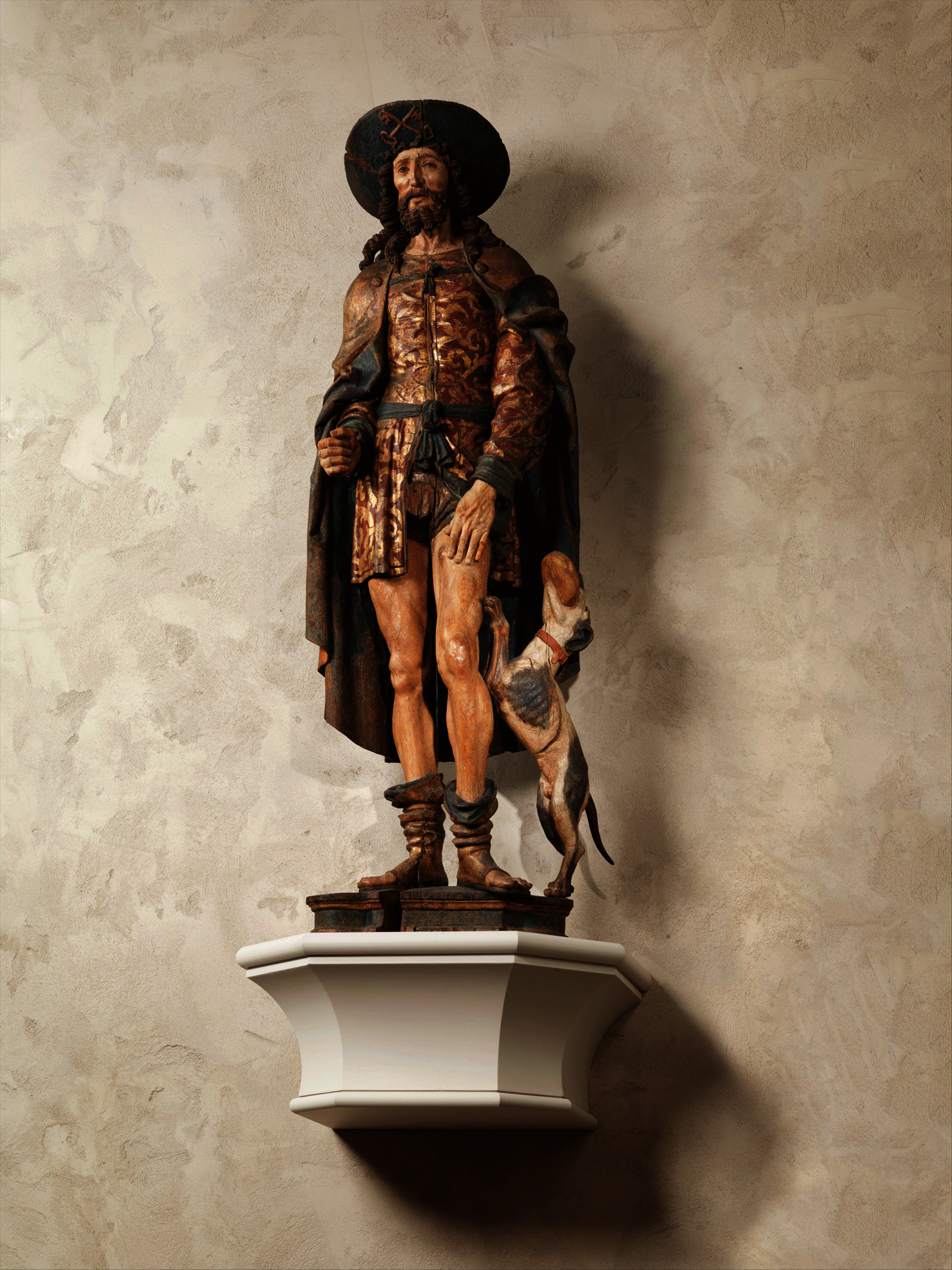
FIG. 5
Francesco Francia
Italian, 1447–1517
Saint Roch, 1502
Tempera on wood
216.5 × 150.8 cm. (85 1/4 × 59 3/8 in.)
Gift of George R. Hann, 1965
The Metropolitan Museum of Art
Image
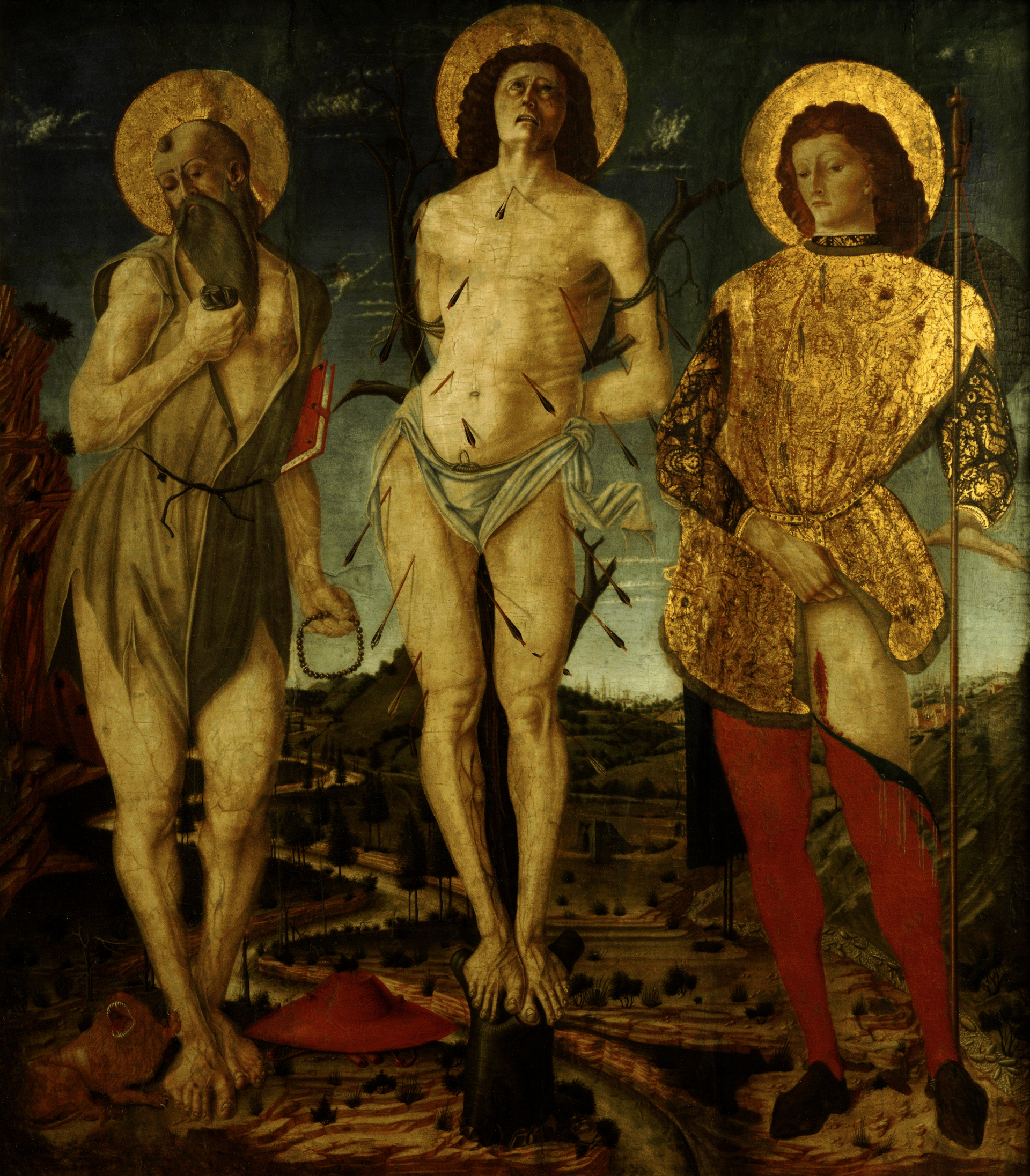
6
FIG. 6
Niccolò Colantonio
Italian, ca. 1420–after 1460
Saints Jerome, Sebastian, and Roch,
ca. 1470–1480
Oil on poplar wood
bpk-Bildagentur / Gemäldegalerie /
Staatliche Museen / Berlin / Germany /
Photo: Volker-H. Schneider / Art Resource, NY
Aesthetic practices centered on visual representations of saints in a visible state of corporeal turmoil and dissolution are closely connected with the imagery of Christ’s passion. Depictions of both St. Sebastian and St. Roch often feature Christ-like characteristics, such as the slightly tilted head and mild, sorrowful expression of St. Roch in the RISD Museum, but also the showing of wounds. Detailed depictions of Christ’s suffering and death became overwhelmingly popular during the later Middle Ages, allowing for new ways of experiencing and expressing religious devotion.15 Many practices of piety became associated with mental exercises aimed at bringing forth images of the passion in front of the inner eye. These images, focusing, in turn, on different aspects of the physical and emotional pain endured by Christ and his mother, were emotionally charged. During these exercises, the believer’s body itself became a pictorial medium. For example, the physiological processes underlying the so-called imagination theory, which came to prominence during the later Middle Ages, were thought to bring into effect material changes within the body based on optical perceptions, but also mental images, dreams, visions, and feelings.16 Religious practices such as the compassionate contemplation of vulnerable bodies, including those of Christ and his saints, served to instill a longing for assimilation and interconnectedness through shared pain. They also created valued knowledge pertaining to specific forms of embodiment that were characterized by dissolving boundaries, fragmentation, and dissolution.
These practices, and the specific knowledge they generated, are centered on various forms of what we could describe as disability experience.17 We can therefore try to study them as premodern disability aesthetics. Margrit Shildrick, among others, has pointed out that in modern Western thought, illness, impairment, and disability are defined by a lack of corporeal boundaries: being sick or disabled is understood as a state of dissolution that has to be overcome. Consequently, health and well-being are constructed as attributes of a subject that is defined by its boundaries and its consolidation as a unified entity.18 By contrast, premodern concepts of corporeality consider all human bodies instable, permeable, and changeable. To varying degrees, all human beings were thought to share in this inherent vulnerability. In some respects, inhabiting a body shaped by illness, impairment, injury, or pain was a state to aspire to, either by following Christ’s suffering directly, like saints and martyrs, or through empathetic acts of assimilation through visual practices.
Crucially, the act of immersing oneself in passion imagery and the suffering of saints could then become a powerful protection against illness. To look upon an image of St. Roch, for example, was to honor and share in the pain of the saint, but also, in turn, to evoke his intercession and protection. Engaging with images was to communicate with them, to offer oneself up to painful experiences that had elevated the saint almost to the level of Christ. From this position, St. Roch and other saints were accessible as intermediaries. Can we also approach them as representatives of premodern disability experience?
It should be pointed out that the concepts of interconnectedness and intercorporeality described above could also result in prejudice against and social rejection of sick and disabled people. This extended to the very act of seeing itself, which was understood as an active material process. In this regard, certain illnesses and conditions—among them the plague—were thought to be transmissible through vision. At least in part, this notion might have been based on the intromission theory, according to which visual “objects sent forth rays that were ‘captured’ by the eye.” It is therefore not unlikely that during plague epidemics, sick people were isolated due to a fear of their spreading infection merely through their visibility: “Part of this notion was that the object (in this case the sick person) emitted a ‘species’ or ‘likeness’ into the air that would be carried right to the eye of the beholder. The rays from the object of sight fall on the spherical surface of the pupil and then penetrate through the three humors of the eye and along the optic nerve. It was reputed that these rays had the potential to transmit the disease.”19 In times of crisis, it is rather likely that these fears were projected onto strangers, especially those with conspicuous bodily or mental characteristics. This experience is also central to the narrative and iconographic traditions of the cult of St. Roch: not only is he usually depicted as a pilgrim, but one of the most prominent aspects of his biography is that he supposedly died a stranger in a prison at or close to his hometown, made unrecognizable and “other” through his illness and isolation.
The statue of St. Roch in the RISD Museum addresses this inherent ambivalence by highlighting the saint’s social isolation, exemplified by the moving image of the dog as his only companion. At the same time, the gesture relating to the plague wound already indicates his elevated position as an intercessor for humankind. In turn, audiences who first approached the statue might have experienced a complex array of conflicting emotions and maybe even physical reactions. In order to explore them in greater detail, more research is needed. To this end, studying premodern disability aesthetics can help us to reconsider our own perspectives and become defamiliarized with our own unquestioned habits of “seeing.” By cripping representations such as the statue of St. Roch, diverse and, to us, non-normative forms of embodiment find a new place within art history and visual studies: not in the margins, but the very center.
- RISD Museum 21.398, https://risdmuseum.org/art-design/collection/saint-roch-21398. Made of wood and paint, the statue measures 105.4 cm. (41 1/2 in.). It was acquired in 1921. See L. Earle Rowe (1923), “Wooden Statue of St. Roch,” Bulletin of the Rhode Island School of Design 11, no. 3 (July 1923): 31–32.
- Considering the sculpture’s stylistic features, Rowe places it “in the center of France, somewhere near Paris or the Loire.”
- Antonio Rigon and André Vauchez, eds., San Rocco: Genesi e prima espansione di un culto (Brussels: Société des Bollandistes, 2006). See also Marie-Theres Schmitz-Eichhoff, St. Rochus: Ikonographische und medizin-historische Studien (Cologne: Forschungsstelle des Instituts für Geschichte der Medizin der Universität zu Köln, 1977).
- There is still some uncertainty concerning the circulation and cultural impact of the earliest known versions of Roch’s vita. The main problems are outlined by Pierre Bolle, “Archival Documents, Early Printed Books, and Manuscripts: The Backwards Text-Tradition of St. Roch ‘of Montpellier,’” in The Saint between Manuscript and Print: Italy 1400–1600, ed. Alison Knowles Frazier (Toronto: Center for Reformation and Renaissance Studies), 143–82: The printed vita by Franciscus Diedus, Vita sancti Rochi (Milan: Simon Magniacus, after June 1, 1479) was probably quite influential, whereas the significance of the anonymous so-called Acta breviora might have been overstated (Historie plurimorum sanctorum noviter addite et prolongate [Cologne: Ulrich Zell, 1483], fol. 452–55). The manuscript versions on which the editions in Acta Sanctorum, August 3 (1867), 399–407 and 407–10 are based did not contribute significantly to the proliferation of the cult.
- Neithard Bulst, “Heiligenverehrung in Pestzeiten: Soziale und religiöse Reaktionen auf die spätmittelalterlichen Pestepidemien,” in Mundus in imagine: Bildersprache und Lebenswelten im Mittelalter, ed. Andrea Löther (Munich: Fink, 1996), 63–97, 77.
- Pierre Bolle, “Archival Documents.”
- The earliest surviving versions of Roch’s vita offer contradictory and sometimes confusing information on his supposed date of birth; some avoid this question altogether.
- Sharon L. Snyder and David T. Mitchell, Cultural Locations of Disability (Chicago: University of Chicago Press, 2014), 202.
- In this view, disability is unquestioningly associated with “defective” bodies and minds.
- In art works, this figure is usually depicted in a stereotypical way. In hagiographical contexts, disabled beggars even serve as iconographical attributes that were meant to help identify specific saints.
- Tobin Siebers, Disability Aesthetics (Ann Arbor: University of Michigan Press, 2010), 1–2
- Siebers, Disability Aesthetics, 3. Siebers argues convincingly that disability can be considered an essential concept of contemporary art. However, his approach can also provide impulses for much-needed reconceptualizations in the fields of visual (and non-visual) studies concerned with premodern culture.
- Rowe, “Wooden Statue of St. Roch,” 31.
- Schmitz-Eichhoff, St. Rochus.
- Christine M. Boeckl, Images of Plague and Pestilence: Iconography and Iconology (University Park, PA: Penn State University Press, 2001), 75–76.
- Suzannah Biernoff, Sight and Embodiment in the Middle Ages (Basingstoke, UK: Palgrave Macmillan, 2002).
- Janet Price and Margrit Shildrick, “Bodies Together: Touch, Ethics and Disability,” in Disability/Postmodernity. Embodying Disability Theory, ed. Mairian Corker and Tom Shakespeare (London: Continuum, 2002), 62–75. Price and Shildrick have highlighted some of these aspects: “The disintegrity and permeability of bodies, the fluctuations and reversibility of touch, the inconsistency of spatial and morphological awareness, the uncertainty of the future, are all features that may be experienced with particular force in the disabled body, but they are by no means unique to it.”
- Margrit Shildrick, “Becoming Vulnerable: Contagious Encounters and the Ethics of Risk,” Journal of Medical Humanities 21: 215–27.
- Pamela C. Berger, “Mice, Arrows, Tumors: Medieval Plague Iconography North of the Alps,” in Piety and Plague: From Byzantium to the Baroque, ed. Franco Mormando and Thomas Worcester (Kirksville, MO: Truman State University Press), 23–63. The intromission theory goes back to Aristotle and other classical authors; it gained prominence again during the later Middle Ages. However, the so-called emission theory, based on the notion that the eyes send forth rays, was still popular during that time as well. See Michael Camille, “Before the Gaze: The Internal Senses and Late Medieval Practices of Seeing,” in Visuality Before and Beyond the Renaissance: Seeing as Others Saw, ed. Robert S. Nelson (Cambridge, UK: Cambridge University Press, 2000), 197–223.
Cite this article as
Chicago Style
MLA Style
Shareable Link
Copy this page's URL to your clipboard.

